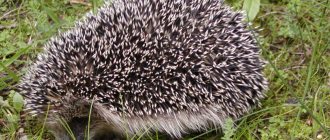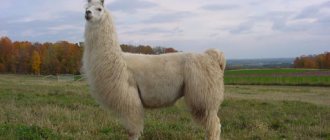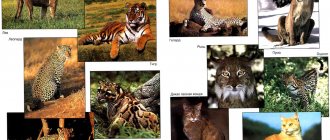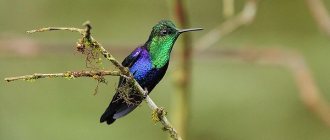- Wild animals
- >>
- Mammals
The striped hyena is not a very large predator. The dimensions are more like an average dog. The animal is not distinguished by any grace, beauty, or attractiveness. Due to the high withers, lowered head and jumping gait, it resembles a cross between a wolf and a wild boar. The striped hyena does not form packs, lives in pairs, and raises up to three puppies. The striped hyena is a nocturnal predator. Activity occurs in the evening and night. During the day, hyenas sleep.
Origin of the species and description
Photo: Striped hyena
Hyaena hyaena is a mammalian predator of the genus hyena. Belongs to the family Hyaenidae. The varieties differ little from each other. There are minor differences in size, color and coat.
They are mainly divided by habitat:
- Hyaena hyaena hyaena is especially common in India.
- Hyaena hyaena barbara is well represented in western North Africa.
- Hyaena hyaena dubbah - settles in the northern territories of eastern Africa. Distributed in Kenya.
- Hyaena hyaena sultana - common in the Arabian Peninsula.
- Hyaena hyaena syriaca – Found in Israel and Syria, known in Asia Minor, in small quantities in the Caucasus.
Interesting fact: The striped hyena looks like four animals at once: a wolf, a wild pig, a monkey and a tiger. The name was given to the hyena by the ancient Greeks. Noticing the resemblance to a wild pig, they called the predator hus. The flat muzzle of a hyena resembles the muzzle of a monkey, the transverse stripes give it a similarity to a tiger.
People of different nations living on different continents attributed mystical qualities to the hyena because of its unusual appearance. Amulets in the form of a hyena still serve as amulets for many tribes in Africa. The hyena is considered a totem animal. Revered as a tribal, clan and family protector.
Domestic hyena, how to keep a hyena at home
Domestic hyenas are famous for their devotion to their owners. Only exotic lovers should weigh the pros and cons a thousand times before getting such a pet.
Only a strong-willed and physically strong person can become the owner of this predator. To earn the devotion and absolute submission of the beast, you must become its leader; a strict hierarchy reigns in the hyena clan. Remember that a hyena has a jaw of steel and even playfully it can cause serious injuries to a person.
Don't forget that hyenas smell disgusting. In nature, animals mark territory using a smelly secretion from glands under their tails. When they see the leader, it is customary for hyenas to turn their rectum outward with all its contents. The predator also likes to wallow in carrion.
The signals emitted by hyenas are also quite unpleasant - laughter and howls. They greet the leader with sounds reminiscent of gagging.
If the decision to get a hyena is final, then the owner needs to provide her with comfortable living. Do not keep a hyena in an apartment; it is better to keep your pet in a country house in a spacious enclosure with strong steel bars. You should take into account the pet’s natural habitat; it likes coolness, but cold does not.
Representatives of the hyena family are quite sociable, the owner will have to pay a lot of attention to the pet. With a lack of entertainment, the predator will hunt all living things very creatively.
Appearance and features
Photo: Animal striped hyena
The striped hyena, unlike its relatives, does not make sharp coughing cries or howl. Can be distinguished from other species by hearing. Makes deep bubbling sounds, growls and grumbles. It has a sloping, as if descending body. The front legs of the predator are much longer than the hind legs. On a long neck rests a large, wide head with a blunt muzzle and large eyes. The ears disturb the proportion of the head. They are distinguished by large pointed triangles.
Video: Striped hyena
Striped hyenas have a long, shaggy coat with a gray mane on their long neck and back. The color is yellowish-gray with vertical black stripes on the body and horizontal stripes on the legs. In an adult striped hyena, the length from the base of the head to the base of the tail reaches 120 cm, the tail - 35 cm. The female can weigh up to 35 kg, the male up to 40 kg.
The hyena has strong teeth and well-developed jaw muscles. This allows the predator to cope with the strong bones of large animals, such as giraffe, rhinoceros, and elephant.
Interesting fact: Female hyenas have false sexual characteristics. They are very similar to males. For a long time it was believed that the hyena is a hermaphrodite. Another fact to add to the mythical nature of the predator. In stories and legends, the hyena has the ability to change gender.
Females are larger, although lighter in weight. They are more aggressive and, as a result, more active. Striped hyenas form pairs and sometimes live in small groups. The leader is always the female. In its natural habitat, the life expectancy of a predator is usually 10-15 years. In nature reserves and zoos, the hyena lives up to 25 years.
Interesting facts about the animal
- The hyena gets its name from the Greek word hus, which means “pig.” So the Greeks pointed out the similarity with a wild pig. In addition, it has long been believed that the animal resembles both a monkey, a wolf and a tiger.
- A cowardly predator is afraid of an open fight. He even runs away from a dog that is smaller than him. He accepts a fight only if there is no other choice. But even here the cunning man often pretends to be dead in order to deceive the enemy.
- The indigenous people of North Africa believe that certain parts of the hyena have healing or magical powers. For example, liver is used to treat eye diseases, dried kidneys are carried with you to get rid of headaches, and crushed heart is taken for stomach problems. The striped skin protects crops from pests.
- The dried tail of a striped hyena is considered a good-luck amulet in Turkmenistan.
- Legends claim that the beast changes gender if necessary. Among scientists of past centuries, for a long time there was an opinion about the hermaphroditism of hyenas. This is explained by the fact that females have false sexual characteristics and are similar to males, sometimes exceeding them in size, although they are always inferior in weight.
Where does the striped hyena live?
Photo: Striped hyena Red Book
The striped hyena is currently the only species found even outside of Africa. It can be found in the countries of Central Asia, the Middle East and India. Hyenas live in Morocco, on the northern coast of Algeria, in the northern parts of the Sahara.
Interesting fact: Hyenas never settle in areas that are covered with snow for a long time. However, the striped hyena can survive in areas with persistent winters of 80 to 120 days, where temperatures drop to minus -20 °C.
These are heat-loving animals that prefer hot and dry climates. They manage to survive in dry areas with little water. The striped hyena prefers to live in open, semi-arid areas. These are mainly dry savannas, acacia forests and shrubs, arid steppes and semi-deserts. In mountainous areas, the striped hyena can be seen at altitudes of up to 3300 m above sea level.
In North Africa, the striped hyena prefers open forested areas and mountainous areas with scattered trees.
Interesting fact: Despite their resistance to drought, hyenas never settle deep in desert areas. Animals need constant drinking. When water is available, it has been noted that hyenas constantly approach springs to drink.
The entrance holes in the striped hyena's den have a diameter of 60 cm to 75 cm. The depth is up to 5 m. This is a pit with a small vestibule. There are known cases when striped hyenas dug catacombs up to 27 - 30 meters long.
Habitat
The striped hyena prefers clayey deserts, but is often found in rocky foothills. It inhabits the most barren lands, often covered with thorny bushes. The hyena is found among rocky hills and gorges, as well as in open savannas with dense grass. Tries not to settle in deserts, needs free access to water. The reservoir should be located within a radius of no more than ten kilometers.
What does the striped hyena eat?
Photo: Striped hyena
The striped hyena is a scavenger of wild ungulates and livestock. The diet depends on the habitat and the fauna that is represented in it. The diet depends on the remains of prey killed by large carnivores such as the spotted hyena or large felines such as leopard, lion, cheetah and tiger.
The striped hyena's prey can be domestic animals. Following herds of domestic animals on pastures, hyenas prowl in search of sick and wounded individuals, performing the role of an orderly. This species is often suspected of killing livestock and hunting large herbivores. There is little evidence for these assumptions. Studies of bone fragments, hairs and feces in central Kenya have shown that striped hyenas also feed on small mammals and birds.
Interesting fact: Hyenas are not averse to eating turtles. With their powerful jaws they are able to crack shells. Thanks to their strong teeth and well-developed jaw muscles, hyenas are also capable of breaking and grinding bones.
The diet is supplemented with vegetables, fruits and invertebrates. Fruits and vegetables can form a significant part of their diet. Animals can survive successfully with very little even salt water. Fruits and vegetables, such as melons and cucumbers, are regularly consumed as a replacement for water.
Striped hyenas can migrate long distances in search of food. In Egypt, small groups of animals were observed accompanying caravans at a respectful distance and reaching speeds of 8 to 50 km per hour. The hyenas walked in the hope of prey in the form of fallen pack animals: camels and mules. Hyenas prefer to eat at night. The exception is cloudy weather or rainy periods.
Lifestyle
Hyenas are active mainly at dusk and at night. Very strong jaws and teeth, an efficient digestive system and the ability to travel long distances all make hyenas successful scavengers.
Food and hunting
Carcasses of dead animals form the basis of the diet of brown and striped hyenas. They supplement their menu with invertebrates, wild fruits, eggs and occasionally small animals that they manage to kill.
Spotted hyenas are not only effective scavengers, but also good hunters. They are capable of chasing prey at a speed of 60 km/h, covering a distance of up to 3 km. They usually hunt young large antelopes (oryx, wildebeest). They can cope with an adult zebra, and often with a buffalo.
Spotted hyenas often hide food in silty ponds. If they are hungry, they return to their hiding places.
Hyenas have an unusually well-developed sense of smell: they can smell the smell of decaying meat located several kilometers away from them.
In terms of nutrition, aardwolves are radically different from their relatives. Their diet mainly consists of termites and insect larvae.
It is interesting that termites try to defend themselves by spraying a burning substance, but there is no control over the aardwolf. His bare nose is so dense that insects cannot bite through it.
Brown hyenas prefer to hunt alone; their spotted relatives often form groups.
Features of character and lifestyle
Photo: Animal striped hyena
The lifestyle, habits and habits of the striped hyena differ according to habitat zones. In Central Asia, hyenas live monogamously, in pairs. Puppies from the previous year remain in the families. They help care for the newborn litter. Family ties last a lifetime.
In Central Kenya, hyenas live in small groups. These are harems, where one male has several females. Sometimes females coexist together. These are groups of 3 individuals and above. Sometimes females are not associated with each other and live separately.
In Israel, hyenas live alone. In areas where striped hyenas live in groups, the social structure is organized in such a way that males are dominant. Hyenas mark their territory with secretions from the anal glands and are demarcated.
The striped hyena is believed to be a nocturnal animal. However, camera traps record striped hyenas in broad daylight in places inaccessible to human habitation.
Hunting
Hyenas have a strong reputation as scavengers, but this is not an entirely accurate description. Yes, hyenas eat carrion, but they are also amazing hunters.
While hunting, cat-like predators reach speeds of up to 60 km/h. Hyenas hunt in groups or alone, depending on the chosen prey. For example, a springbok antelope is hunted by one hyena, and a wildebeest is hunted by a group of 3 predators. When hunting large animals, hyenas gather in packs. They eat their prey while it is still alive, lowering their jaws into its stomach. The victim has no chance to escape.
Hungry hyenas are very dangerous even for the largest animals: elephants, old lions. When starting to hunt, predators make terrifying sounds - wild laughter that turns into a howl.
More on this topic: Is the Grand Canyon worth traveling?
Animals are most active at night; during the day they usually rest in their burrows.
Social structure and reproduction
Photo: Striped hyena cub
Female striped hyenas come into heat several times a year, making them very fertile. A hyena bears its cubs for about three months. Before giving birth, the expectant mother looks for a hole or digs it herself. On average, three puppies are born in a litter, less often one or four. Hyena cubs are born blind and weigh about 700 grams. After five to nine days, both their eyes and ears open.
At about a month old, puppies are already able to eat and digest solid food. But the female, as a rule, continues to feed them milk until they are six months or a year old. Female striped hyenas reach sexual maturity after one year, and they can bear their first litter at the age of 15-18 months. However, in practice, hyenas give birth for the first time at 24-27 months.
Care for the offspring is carried out exclusively by females. The male hyena does not even appear in the den. Scientists have measured two lairs in the Karakum Desert. The width of their entrance holes was 67 cm and 72 cm. At the same time, the burrows went underground to a depth of 3 and 2.5 meters, and their length reached 4.15 and 5 m, respectively. Each lair is a single space without “rooms” or branches.
At the same time, hyena shelters found in Israel have a more complex structure and are much longer – up to 27 m.
Reproduction of hyenas in nature
In hyenas, it is difficult to distinguish the sex of the animal. Due to high testosterone, the female's clitoris resembles the male's genital organ.
Male hyenas have to fight for the female's affections. The winner approaches the hyena very respectfully, tilting his head down, and only with her consent does conception occur.
When females pass by, males give way to them. Only a respectful attitude allows the male to win over the female. If you are lucky and the “queen” pays attention to him, then his status among his peers will instantly increase, he will become a leader.
Hyenas can breed at any time, but more often the pups appear from August to early January. Each species of hyena has its own rules. For example, spotted ones mate with individuals from their own flock, while brown ones have a male mate with a female from another clan.
Natural enemies of the striped hyena
Photo: Striped hyena from the Red Book
In the wild, the striped hyena has quite a few enemies. It is not a serious opponent for any predator living in the same territory.
This is explained by the habits of the hyena and its behavior:
- The hyena lives extremely solitary, not gathering in packs;
- She looks for food mainly at night;
- When meeting large predators, maintain a distance of at least 50 meters;
- Moves slowly, in zigzags.
This does not mean that the hyena does not have conflicts with other animals. There are cases when hyenas had to fight with leopards and cheetahs in order to drive them away from food. But these are rather one-time incidents that do not make larger predators of other species natural enemies of hyenas.
Unfortunately, this cannot be said about people. Striped hyenas have a bad reputation. They are believed to attack livestock and even raid cemeteries. That is why the population in the habitats of hyenas considers them enemies and tries to destroy them at the first opportunity. In addition, the striped hyena is often the target of poaching.
In North Africa, it is generally accepted that the internal organs of a hyena are capable of healing a variety of diseases. For example, hyena liver has been used to treat eye diseases since ancient times. It is also believed that the skin of the striped hyena can protect crops from destruction. All this leads to the fact that killed hyenas become a hot commodity on the black market. Poaching of hyenas is especially widespread in Morocco.
Description of the animal
The striped hyena is one of four species of the hyena family. Outwardly, it very much resembles a large dog. The body length reaches 120 cm, the tail adds another 30 cm. Weight ranges from 27 to 54 kg. The body is short, with a high anterior part. Height at withers – up to 80 cm.
A strong neck supports a large skull with massive jaws and zygomatic arches. The teeth are huge, thick, powerful fangs. Even the largest bones are easily susceptible to them. The ears are large, wide, pointed at the top.
The paws are strong and have four toes, slightly curved. The hind legs are much shorter than the front ones. The line of the back to the croup decreases. Therefore, it seems as if the animal, when moving, lowers its butt and drags it. The fingers end in long but blunt claws. They are of little help in tormenting prey or fighting, but are very useful for digging in the ground.
| Scientific classification | |
| Domain | Eukaryotes |
| Kingdom | Animals |
| Sub-kingdom | Eumetazoans |
| No rank | Bilaterally symmetrical |
| No rank | Deuterostomes |
| Type | Chordata |
| Subtype | Vertebrates |
| Infratype | Ghostostomes |
| Superclass | Quadrupeds |
| Treasure | Amniotes |
| Class | Mammals |
| Subclass | Animals |
| Treasure | Eutheria |
| Infraclass | Placental |
| Superorder | Laurusasatheria |
| Squad | Predatory |
| Suborder | Felidae |
| Family | Hyenas |
| Subfamily | Hyaeninae |
| Genus | Striped hyenas |
| View | Striped hyena |
| International scientific name | Hyaena hyaena |
| Security status | Close to vulnerable |
The body and tail of the animal are covered with thick, coarse hair, no longer than 7 cm. Along the ridge, the fur is hard and forms a high (up to 30 cm), standing mane. The species owes its name to its yellowish-brown color with a striped pattern. The color of the skin is almost invisible against the background of the landscape.
You won’t hear a creepy “laugh” from a striped hyena, like from a spotted one. Most often she growls or emits a hoarse, rattling howl.
Character and lifestyle
The hyena is a shy, timid creature, although it often behaves impudently. When meeting animals of another species, especially smaller ones, she is aggressive, her behavior clearly demonstrates a threat, she bares her large teeth and growls. But, sensing danger, he quickly retreats.
This scavenger does not like forests. Inhabits rocky foothills, deserts with clay soil, covered with small shrubs. Some individuals are found among the sands. The proximity of bodies of water is not too important for them. It is enough that the water source is no further than 10 km.
Hyenas cannot stand the cold. Where the snow cover is stable in winter, they do not settle. They often live close to people, but in sparsely populated areas. They often visit poultry houses, livestock barns, and melon fields. Here they eat watermelons and melons, quenching their thirst.
During the day, animals hide in caves, burrows, and rock crevices. At night they wander around the surrounding area, looking for food, most often carrion. Hyenas do not live in packs, but in families consisting of a male, a female and a pair of young individuals. The leader of the group is the male. The young live with their parents for at least a year. The family exists for several years.
She lives in isolation, but 2–3 families can settle close to each other. Observers note the sociability and friendliness within the family. Although predators show aggressive wariness towards other animals.
Near each family den there are several “towns”. These are the names of the habitats that are used most often. The “town” includes several shelters, “latrines,” and “dust baths.” Its area is usually from 50 to 100 m², but it can be huge - up to 2000 m². The total size of the territory of an individual family depends on the amount of food, the availability of places for shelter, and watering places.
The boundaries of the family area are established through scent marks and a very unpleasant howl. Not only the boundaries of the property itself are marked, but also the territory with a radius of more than two kilometers around it.
The den is always very cluttered with food debris and bones. There is a carrion lover who prefers to hide in his hiding place. There is a strong smell of rot in there. The beast itself also emits a sharp, disgusting smell. In the wild, the animal lives from 10 to 15 years. In protected areas, protected areas or zoos, life expectancy reaches 25 years.
What does it eat?
The main diet is carrion. From time to time the night robber attacks small animals. He does not make any special demands on his food. The hyena is practically omnivorous. It eats insects, gnaws at corpses and skeletons, destroys bird nests, and devours fish washed up on the shore of a reservoir.
The menu is periodically replenished with newly hatched turtles. If people live nearby, the animal does not disdain garbage; it climbs into rabbit hutches, chicken coops, and sheepfolds to drag away the lamb.
Where does it live?
The main habitats are the semi-deserts and foothills of North Africa. A smaller number live throughout almost all of Asia, in the Transcaucasus. The range on the territory of the former USSR is limited to the eastern regions of Azerbaijan, Georgia, the south of Uzbekistan, Turkmenistan, and Tajikistan.
In 2010, the body of a hyena entangled in a garden fence was discovered in Armenia, where it had been considered extinct since the 1940s.
Reproduction
Reaching sexual maturity occurs in the third or fourth year of life. If the climate is hot, reproduction is not limited to the season. In the north of their range, animals mate during the winter months.
Pregnancy lasts about 90 days. During the year, the female brings 3 litters, 2–4 cubs each. Babies are born blind. The eyes open on the seventh – ninth day. Both parents care for the offspring. Although in captivity the male is capable of destroying newborns.
Natural enemies
In the wild, few pose a danger to a nocturnal predator. It rarely approaches large animals closer than 50 meters.
A hyena can be attacked by a lion. Not for food, but because he feels an inexplicable hostility towards her, he always strives to strangle her when he meets her.
It happens that death occurs from blows from ostrich paws if the predator steals chicks or eggs from the nest. Meetings with a crocodile or leopard are dangerous. Young animals are sometimes attacked by birds of prey.
Population and species status
Photo: Female striped hyena
There is no exact data on the number of hyenas. This is explained by the fact that the striped hyena, unlike the spotted hyena, is not a gregarious animal. It is safe to say that despite the very extensive range, the number of striped hyenas in each individual territory is small.
The largest number of places where striped hyenas have been seen is concentrated in the Middle East. Viable populations remain in the Kruger National Park in South Africa and the Kalahari Desert.
In 2008, the International Union for Conservation of Nature and Natural Resources listed the striped hyena as a vulnerable species. Striped hyenas are also included in the International Red Book. The reason for inclusion is hostile human activity. Prejudices against hyenas that have accumulated over centuries have made them enemies of local residents both in North Africa and in India and the Caucasus.
In addition, hyenas also live in zoos around the world, for example in Moscow, the capital of Egypt Cairo, American Fort Worth, Olmen (Belgium) and many other places. The striped hyena also lived in the Tbilisi Zoo, but, unfortunately, the animal died in 2015, when there was a severe flood in Georgia.
Food
It is a scavenger by its feeding method. The animal's diet consists of various carrion and food waste. Does not refuse to eat the corpses of both large and medium-sized mammals, such as gazelles, impalas, zebras. If the soft tissues have already been previously eaten by someone, hyenas also gnaw off the bones.
The striped hyena supplements its diet with seeds, fruits, seeds, fish, insects, and occasionally kills small animals: rodents, hares, birds, reptiles. Researchers have identified fifteen species of mammals that can be preyed on by the striped hyena. Some individuals have learned to hunt domestic animals (goats, sheep, dogs). The large proportion of remains of domestic animals and even human remains in the diet of these animals in some regions of their range proves the hyena’s dependence on the customs and lifestyle of the local population. For example, in the Middle East, tombstones, in addition to their traditional function, are an obstacle for hyenas: they prevent them from digging up graves and feeding on human remains.











